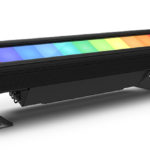
Jere Harris on VER’s Reorganization with PRG
In April, VER announced that it had filed for Chapter 11 bankruptcy protection for its North American operations along with plans to merge with an entity controlled by PRG. On Aug. 22, PRG announced that VER had emerged from Chapter 11 bankruptcy as a reorganized company led by PRG’s chairman and CEO, Jere Harris. PLSN spoke with Jere Harris to get a better understanding of where VER and PRG are now, and where they — and the industry at large — might be headed in the future.
PLSN: How will the two companies be brought together in terms of services provided?
Jere Harris: The company will have common ownership at the top of the food chain, but as time marches on and we get everything sorted out, VER will function and run as a separate company. Both working to our strengths.
PRG is a full-service solutions provider to a broad base of markets and customers, so we will continue on that path. It’s right in our name, Production Resource Group, we are a partner with our customers in the producing or production of events and projects, we will provide a solution that includes equipment but is more centric around people; a full solution that we craft for the customer. So VER’s work on the solutions side of things, that part of VER will now meld or merge into PRG. VER itself will go back to its roots of being a B2B sub-rental company. Again it is in their name, VER is Video Equipment Rentals, renting to staging companies, professionals in the film, television, audio/visual business and all that.
Also I want to mention the people of VER, not the leadership of VER, but the people who work there, are amazingly talented and passionate, great people. There’s a real opportunity to take all the great things that they did and merge that into PRG.
How do you think the industry should view this merger?
I think the first thing, is that the industry, the community that we live in, needs to realize that VER went bankrupt, and I want to stress the word, bankruptcy. VER went bankrupt and 750 million dollars was eviscerated in their bankruptcy. People are focused on, “PRG and VER have merged,” well, we didn’t merge, VER was bankrupt. Either PRG would have ended up with it, or NEP would have ended up with it, or PSAV might have ended up. But for the health of the industry someone had to step in. It’s important that people realize that in the last five years, all of the acquisitions that PRG has done have been companies that are in trouble.
If we still want to have an industry — and we want to have a healthy industry — this bankruptcy at VER is indicative of a serious problem that’s existed in the industry for far too long now. Everybody says, merger and says we are the big bad wolf. That isn’t what happened here; what happened is VER overspent and they undercharged. VER outspent their EBITDA [earnings before interest, taxes depreciation, and amortization] every year by thirty percent in CapEx. So why didn’t VER go bankrupt sooner? It’s very simple, just like a mortgage, if you need $10,000 a month for your mortgage and you’re only taking in $6,000, you can run your credit cards out just so long until they catch up to you. It’s no different in our business. VER had a sort of “We’re going to take over the world and drive everyone out” approach, and that strategy doesn’t work. You know, we all live in a community in this industry.
So, we’re not the big bad wolf and we are not the only company with investors and banks. Everyone has to acknowledge that there are no more companies in our industry that are not owned in some portion by private equities. Everyone likes to talk as if PRG was the only one, but every company in our industry has them today and that’s because the amount of CapEx that we need to employ in order to do the jobs that we do is rising.
Just look at the economics, when we started PRG 25-plus years ago, we had 10 million dollars worth of inventory. Today, whether you take Solotech, LMG, 4Wall, all these companies have hundreds of millions of dollars of inventory. In the case of PRG, it’s even higher. When PRG started, we used to buy a PAR can for 30 bucks. Today, a moving light costs $10,000. I went from having 1,000 lights at $50 a light, which is $500,000 worth of inventory to now I have 500 lights at $10,000 a light, which is five million dollars worth of inventory.
So the message to the industry, especially to our side of the industry, to the manufacturers, to the other rental companies, is that things have got to change here. More collaboration, less CapEx, longer utilization, slight price changes. It doesn’t have to be huge price changes, but there has to be slight pricing changes.
You mentioned utilization and CapEx, that also touches on the rate of new gear entering the market. What do you think about the faster pace of manufacturers developing equipment and introducing it?
I think what happened in the automotive industry, needs to happen here in the entertainment technology side of things. There has to be some rationalization on the equipment cycles, because, if they keep rolling out, rolling out, rolling out — no one can afford that. The manufacturers’ health is only as good as the rental companies or their customers’ health. They need to get rational about what the market size is, what the market channels are, they need to be disciplined and they need to, as the automotive industry did, they need to support and help have a strong dealer network. Especially on the rental companies side. If they have irrational exuberance over the amount of gear that they can sell to the rental companies, I think that that’s going to be a real problem on a going forward basis. Again, we can have a community of the rental companies where the people understand and act on the dynamics that are necessary. If I buy a light today, I have to get the time to get the utilization out of it at full rental price in order to not just make our money back and break even, but to get the proper return.
Any additional thoughts?
I just think that everyone in the industry has to recognize that one of the great companies in the industry went bankrupt. 750 million dollars, just went up in smoke. This is not a good thing for the industry. Even though some people will view that we’re getting the advantage of it, this is not healthy for the industry and it’s not good for our customers. Customers need healthy, strong, financially viable enterprises to do what they need to do.
We need to look at this industry as a community where all the rental companies have got to be able to survive, the LMGs, the PRG’s, the 4Walls. The community needs these companies, every customer doesn’t like everybody, and we need some diversity. And you need to have stability in the marketplace with fair pricing.
Again, the returns don’t have to be crazy, but they have to be sustainable. If we have a weak rental industry, and everybody’s undercutting pricing and undercutting each other, then we have a weak market for goods and services. So, we need to have better relations as an industry. We all have to do our part together, the companies, the manufacturers, and the customers, to keep the industry healthy.
For more information on PRG, visit www.prg.com.


